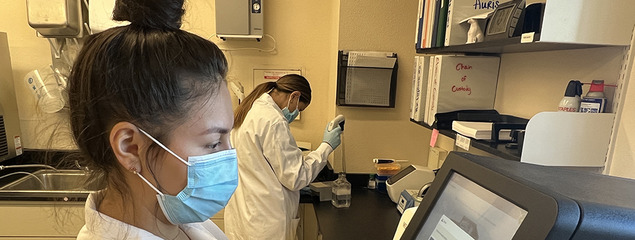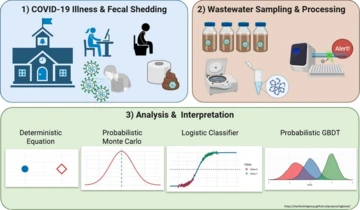
One Health
Research Publications
Affiliates at the Yuma Center for Excellence in Desert Agriculture have published in high-impact scientific journals, including:
1. Innes, GK, Patton, AN, Prasek, S, Brosky, H, Khoury, K, Hodges, T, Schmitz, BW. Introduction to WBE case estimation: A practical toolset for public health practitioners

2. Brosky, H, Prasek, S, Innes GK, Pepper IL, Miranda J, Brierley PE, Slinski SL, Polashenski L, Betancourt WQ, Gronbach K, Gomez D, Neupane R, Johnson J, Weiss J, Yaglom HD, Engelthaler DM, Hepp CM, Crank K, Gerrity D, Stewart JR, and Schmitz BW. A framework for integrating wastewater-based epidemiology and public health

3. Prasek SM, Pepper IL, Innes GK, Slinski S, Betancourt WQ, Foster AR,…,Schmitz BW. Variant-specific SARS-CoV-2 shedding rates in wastewater - PubMed Sci Total Environ. 2023;857:159165.
Mean SARS-CoV-2 waste shedding rates were found to increase with the predominance of the Delta variant and subsequently decrease with Omicron infections. The Delta stage had the highest mean shedding rates and was associated with the most severe disease symptoms reported in other clinical studies, while Omicron, exhibiting reduced symptoms, had the lowest mean shedding rates. Additionally, shedding rates were most consistent across communities during the Omicron stage. This is the first paper to identify waste shedding rates specific to the Omicron variant and fills a knowledge gap critical to disease prevalence modeling.
4. Casey JA, Tartof SY, Davis MF, Nachman KE, Price L, Liu C, Yu K, Gupta V, Innes GK, Tseng HF, Do V, Pressman AR, and Rudolph KE. Impact of a Statewide Livestock Antibiotic Use Policy on Resistance in Human Urine Escherichia coli Isolates: A Synthetic Control Analysis
In the United States, antimicrobial-resistant (AMR) pathogens cause nearly 3 million infections and 35,000 deaths annually. Despite modest declines, sales of antimicrobials for food-animal production represent approximately 65% of antibiotics sold in the United States. Antimicrobial-resistant pathogens may spread from industrial food animal production sites to people through multiple routes, including foodborne, occupational, and environmental exposures. Animals can harbor bacteria from the farm to the processing facility where they can contaminate the retail meat supply, where improperly handled or undercooked meat can lead to human infection.
5. Polanco J, Schmitz BW, Choi S, Safarik J, Prasek S, and Plumlee MH. SARS-CoV-2 genetic material is removed during municipal wastewater treatment and is undetectable after advanced treatment
6. Barber C, Crank K, Papp K, Innes GK, Schmitz BW, Chavez J, Rossi A, and Gerrity D. Community-Scale Wastewater Surveillance of Candida auris during an Ongoing Outbreak in Southern Nevada
7. Prasek SM, Pepper IL, Innes GK, Slinski S, Ruedas M, Sanchez A,…, Schmitz BW. Population level SARS-CoV-2 fecal shedding rates determined via wastewater-based epidemiology - PubMed Sci Total Environ. 2022 Sep;838(Pt 4):156535.
Wastewater from six municipalities in Arizona and Florida with distinct demographics were monitored for SARS-CoV-2 RNA between September 2020 and December 2021. Average SARS-CoV-2 RNA fecal shedding rates were unique to each community and influenced by population demographics. Age, ethnicity, and socio-economic factors may have influenced shedding rates. Findings in this study suggest that community-specific shedding rates may be appropriate in model development relating wastewater virus concentrations to clinical case counts.
8. Schmitz BW, Innes GK, Prasek SM, Betancourt WQ, Stark ER, Foster AR, et al. Enumerating asymptomatic COVID-19 cases and estimating SARS-CoV-2 fecal shedding rates via wastewater-based epidemiology - PubMed Sci Total Environ. 2021 Aug 20;801:149794.
Wastewater-based epidemiology was utilized to monitor SARS-CoV-2 RNA in sewage collected from manholes specific to individual student dormitories at the University of Arizona in the fall semester of 2020, which led to successful identification and reduction of SARS-CoV-2 transmission events. Positive wastewater samples triggered clinical testing of residents within that dorm; thus, SARS-CoV-2 infected individuals were identified regardless of symptom expression. Nasal and nasopharyngeal swab samples processed via antigen and PCR tests indicated that 79.2% of SARS-CoV-2 infections were asymptomatic, and only 20.8% of positive cases reported COVID-19 symptoms at the time of testing. Clinical data were paired with corresponding wastewater virus concentrations, which enabled calculation of viral shedding rates in feces per infected person. Mean shedding rates averaged from positive wastewater samples across all dorms were 7.30 ± 0.67 log10 genome copies per gram of feces (gc/g-feces) based on the N1 gene.
9. Betancourt WQ, Schmitz BW, Innes GK, Prasek SM, Pogreba Brown KM, Stark ER, et al. COVID-19 containment on a college campus via wastewater-based epidemiology, targeted clinical testing and an intervention - PubMed Sci Total Environ. 2021;779:146408. .
The University of Arizona (UArizona) utilized WBE paired with clinical testing as a surveillance tool to monitor the UArizona community for SARS-CoV-2 in near real-time, as students re-entered campus in the fall of 2020. Positive detection of virus RNA in wastewater lead to selected clinical testing, identification, and isolation of three infected individuals (one symptomatic and two asymptomatic) that averted potential disease transmission. This case study demonstrated the value of WBE as a tool to efficiently utilize resources for COVID-19 prevention and response.
10. Sherchan SP, Shahin S, Ward LM, Tandukar S, Aw TG, Schmitz B, et al. First detection of SARS-CoV-2 RNA in wastewater in North America: A study in Louisiana, USA - PubMed Sci Total Environ. 2020 Nov;743:140621
This paper investigated the presence of severe acute respiratory syndrome coronavirus 2 (SARS-CoV-2) RNA in wastewater samples in southern Louisiana, USA. To our knowledge, this was the first study reporting the detection of SARS-CoV-2 RNA in wastewater in North America. However, concentration methods and RT-qPCR assays need to be refined and validated to increase the sensitivity of SARS-CoV-2 RNA detection in wastewater
.

